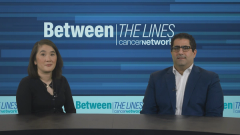
Overview of Real-World Comparative Data for Amivantamab in NSCLC
Joshua K. Sabari, MD, and Helena A. Yu, MD, discuss real-world data comparing amivantamab with other therapies in EGFR exon 20–mutated non–small cell lung cancer.
Episodes in this series

Transcript:
Joshua K. Sabari, MD: Let’s jump into the data in a little bit more detail here for this patient population. So, with amivantamab [Rybrevant], again, 114 patients enrolled in cohort D of the CHRYSALIS study. We looked at a TKI [tyrosine kinase inhibitor] pre-treated patient population. This is in the comparator arm, 69 patients who received osimertinib [Tagrisso] at 80 mg. There were 91 patients in the IO [immuno-oncology] arm. These are patients who received immunotherapy or immunotherapy in combination with chemotherapy and most of these patients received PD-1 inhibitors. There were patients in the separate cohort, non-platinum chemotherapy, 87 patients enrolled, mostly docetaxel or taxane-based regimens. Then 57 patients enrolled in a cohort that received a VEGF inhibitor. Medicines like ramucirumab [Cyramza] or bevacizumab [Avastin] plus chemotherapy.
This is a very broad smattering of what you’d expect in clinical practice in the community in the second-line setting. We utilize this data to compare it to the amivantamab-treated population. I’m curious for the TKI group of 69 patients where we talked about osimertinib being utilized. Do you think that physicians think that has a response there or they’re just using the wrong therapy in the wrong patient?
Helena A. Yu, MD: It’s hard to tell. I do think that in a community practice where you’re seeing so many different types of patients, seeing an EGFR mutation of any kind is quite rare and so understanding the nuances between the different types can be really challenging and would be challenging for me as well. Then again, we talked about those NGS [next-generation sequencing] reports and how they can be alphabet soup in terms of figuring out the meaning behind the different specific insertions. I suspect it’s probably a bit of both, where they see EGFR mutation and they give the TKI, but I think there is a clear education piece where we can say, if you’re going to do something targeted, do one of these ones that’s approved.
Joshua K. Sabari, MD: What’s the rationale for VEGF and chemotherapy? Did we see that utilized in the 57 patients received in the comparator arm VEGF inhibitor and chemotherapy?
Helena A. Yu, MD: I tend to do this. I do think that there is some data that VEGF inhibition in these EGFR-mutant lung cancers. There might be enhanced activity. Typically, based on the REVEL study, it’s usually in combination with docetaxel, so docetaxel plus ramucirumab in that second-line chemotherapy setting. I think that that’s reasonable, but again, that’s not something that all patients are able to tolerate. There is a lot of exclusion criteria for VEGF inhibitors.
Joshua K. Sabari, MD: So, clearly, we have some data for exon 19 and exon 21 insertion mutations. Is there any specific data for EGFR exon 20 insertion mutations and VEGF inhibitors? Not that I know of.
Helena A. Yu, MD: Not that I know of.
Joshua K. Sabari, MD: We looked at these cohorts and we matched for specific factors that we mentioned, prior lines of therapy, brain metastasis, whether yes or no, or the data was missing. In terms of age, we looked at cutoffs of less than 55 years old, 55 to less than 60 years old, and then greater than 60 years old. We know that age may be an important marker of response and durability. We looked at gender. We also looked at the number of metastases and most importantly, ECOG performance status. We know that in this study, the CHRYSALIS cohort D, where patients enrolled with 0 or 1, in this real-world analysis, we’re not looking at patients with a performance status of 2 or 3. We matched patients who had an ECOG of 0 or 1 in this population.
Now let’s dive into some of the data. When we looked at the adjusted overall survival, and this is investigator-assessed progression-free survival, a clear benefit to amivantamab over all the comparator groups that we mentioned. Clearly, amivantamab is better than osimertinib in the TKI group, but all those other combinations commonly utilized in chemotherapy-based taxane regimens or other regimens, for example, chemotherapy and immunotherapy. So, I thought this data was quite dramatic and also helped me better understand what people were doing in clinical practice.
Helena A. Yu, MD: I totally agree. I think that in particular, overall survival is a very black-and-white end point. I think in particular in the data that you all put together, that the overall survival curve for amivantamab really is far separated from the bunched-up other targeted therapies given. That was quite a convincing piece of data for me.
Joshua K. Sabari, MD: When we looked at the IPW [inverse probability weighting], this weighted adjustment for different regimens and different factors, still clearly amivantamab appeared to be better as a regimen with all the end points we mentioned compared to the other regimens. So really, as authors, we concluded here that this analysis really highlights the value of amivantamab for addressing this unmet need in patients with advanced non–small cell lung cancer with EGFR exon 20 insertion mutations in the second-line setting. It really gave me a real-world flavor because we know what we do in our clinical practice, but what happens out in the community. This study really solidified that for me. This does appear to be better than some of the other regimens utilized. We need a prospective randomized study to confirm that, but I think the data allows me to have discussions with community oncologists. Clearly, education is needed in discussing regimens in the second line and importantly educating clinicians about the importance of EGFR exon 20 insertion mutations.
Transcript edited for clarity.
Newsletter
Stay up to date on recent advances in the multidisciplinary approach to cancer.



















































































